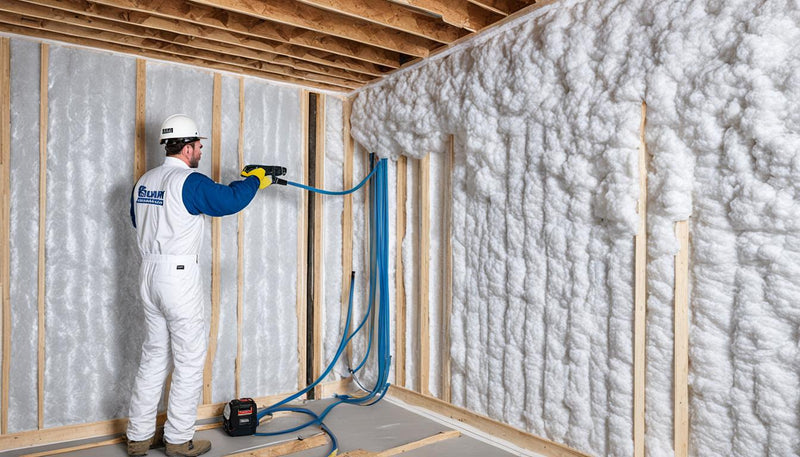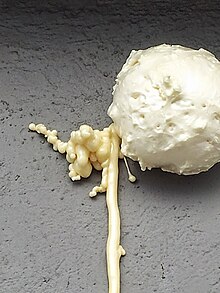Typical Myths Regarding Spray Foam: Debunking the Misconceptions
Typical Myths Regarding Spray Foam: Debunking the Misconceptions
Blog Article
Spray Foam: The Ultimate Solution for Air Sealing and Insulation
Spray foam insulation has become a leading service for effective air sealing and thermal insulation, offering an one-of-a-kind combination of buildings that establish it apart from traditional techniques. Its ability to increase and fill spaces makes it especially reliable in stopping air leakage, which can dramatically affect power efficiency. Understanding the complete range of its advantages, installation processes, and comparisons with other insulation types is critical for making educated decisions. As we check out these aspects, the implications for both new buildings and retrofits come to be significantly significant. What aspects should influence your choice?
What Is Spray Foam?
Spray foam is a versatile insulation product that integrates the concepts of air sealing and thermal resistance to improve power efficiency in structures. Composed mainly of polyurethane or other comparable compounds, spray foam is applied as a fluid that expands upon contact with surface areas, creating a strong, continuous layer of insulation. This one-of-a-kind home permits it to fill up voids, fractures, and gaps that conventional insulation products might overlook, offering a remarkable air seal.
There are 2 major types of spray foam: open-cell and closed-cell. Open-cell spray foam is lighter and a lot more adaptable, offering exceptional audio absorption and a reduced R-value per inch - Spray Foam. In contrast, closed-cell spray foam is denser, giving a greater R-value, moisture resistance, and included architectural integrity to developing parts
The application process typically includes customized devices, guaranteeing a seamless application that abides by numerous substratums, consisting of wood, concrete, and steel. This adaptability makes spray foam appropriate for both brand-new buildings and retrofitting existing structures. Its ability to produce an airtight obstacle significantly adds to minimizing energy intake and boosting indoor air top quality, therefore making it a recommended choice amongst builders and homeowners alike.
Advantages of Spray Foam Insulation
Among one of the most significant advantages of spray foam insulation is its outstanding capacity to develop a continuous air obstacle, which efficiently reduces energy loss. Unlike conventional insulation materials, spray foam broadens to fill gaps and cracks, ensuring that air leakage is significantly decreased. This characteristic not only enhances energy effectiveness yet likewise causes reduce energy expenses in time.
In addition, spray foam insulation provides remarkable thermal resistance, contributing to a more steady indoor atmosphere. Its high R-value per inch enables effective insulation in restricted spaces, making it suitable for attic rooms, walls, and crawl spaces. The moisture-resistant residential or commercial properties of spray foam aid protect against mold and mildew and mold development, advertising much healthier living conditions.
An additional essential advantage of spray foam insulation is its sound-dampening high qualities (Spray Foam). It effectively reduces sound transmission between areas, producing a quieter and more comfortable home atmosphere. The durability of spray foam additionally stands apart, as it does not droop or resolve in time, preserving its efficiency throughout its life expectancy
Just How Spray Foam Works
Understanding exactly how spray foam insulation works is crucial for valuing its efficiency in air securing and thermal resistance. Spray foam insulation consists of 2 main components: isocyanate and polyol material. When these parts are combined, they go through a chain reaction that triggers the product to increase quickly, creating a thick foam that loads voids, cavities, and splits.
As the foam increases, it follows surface areas, creating an airtight seal that significantly decreases air infiltration. This characteristic makes spray foam insulation highly effective at preventing drafts view it and wetness infiltration, which can result in energy loss and damages with time. In addition, the closed-cell variation of spray foam supplies premium thermal resistance as a result of its stiff structure, successfully reducing warm transfer.
The special residential properties of spray foam permit it to adhere to uneven surfaces, making certain detailed coverage and a seamless obstacle. Therefore, spray foam insulation not only enhances power performance but also contributes to enhanced interior air Go Here top quality by reducing the buildup of toxins and irritants. Ultimately, recognizing the mechanics behind spray foam emphasizes its role as a premium selection for insulation and air securing in both business and property applications.
Installment Process Review

Before installment, the space needs to be sufficiently cleansed and prepped, ensuring that surfaces are without dirt, particles, and dampness. Because contaminants can compromise attachment and total performance, this step is vital. When the area is prepared, the application involves blending the two components of the spray foam, which expands upon contact and fills spaces properly.
Trained specialists should conduct the installment, utilizing customized devices to make sure uniform protection and optimum density. Security safety measures, including using protective equipment and making certain appropriate air flow, are vital during this process. After application, the foam typically remedies quickly, forming a solid barrier that boosts power effectiveness.
Contrasting Spray Foam to Traditional Insulation
When assessing insulation choices, spray foam insulation attracts attention in contrast to traditional products such as fiberglass and cellulose. One of the primary benefits of spray foam is its premium air sealing capacities. Unlike fiberglass why not try here and cellulose, which can allow air infiltration, spray foam increases upon application, filling up gaps and holes to create a closed seal. This results in enhanced power performance, as less warmed or cooled down air gets away the home, leading to lower energy bills.
Additionally, spray foam supplies a higher R-value per inch than traditional insulation types, supplying even more reliable thermal resistance in a thinner account. This particular is especially beneficial in rooms with restricted tooth cavity deepness. In addition, spray foam is resistant to dampness and mold and mildew growth, which can be a significant worry about cellulose and fiberglass, specifically in damp environments.
However, spray foam insulation generally lugs a higher upfront cost than its standard equivalents. Home owners must evaluate this preliminary investment versus lasting energy cost savings and efficiency advantages. Eventually, while both insulation types offer their objective, spray foam arises as an advanced service for modern insulation demands, specifically in regards to air securing and thermal effectiveness.

Conclusion
In summary, spray foam insulation represents an extremely reliable solution for accomplishing optimum air securing and thermal resistance. Its unique properties, including wetness resistance and noise dampening, make it ideal for numerous applications in both new buildings and retrofitting jobs (Spray Foam). The initial costs might be greater contrasted to typical insulation products, the long-term benefits, such as considerable power financial savings and boosted interior air quality, validate the financial investment and underscore its value in contemporary building techniques.
Spray foam insulation has actually arised as a leading remedy for reliable air sealing and thermal insulation, using a special combination of buildings that set it apart from typical techniques.Spray foam is a functional insulation product that integrates the principles of air sealing and thermal resistance to improve power performance in buildings.When examining insulation options, spray foam insulation stands out in comparison to conventional materials such as fiberglass and cellulose. Ultimately, while both insulation kinds offer their purpose, spray foam arises as a more advanced service for modern insulation needs, specifically in terms of air securing and thermal performance.
In recap, spray foam insulation stands for a very efficient option for accomplishing optimal air securing and thermal resistance.
Report this page